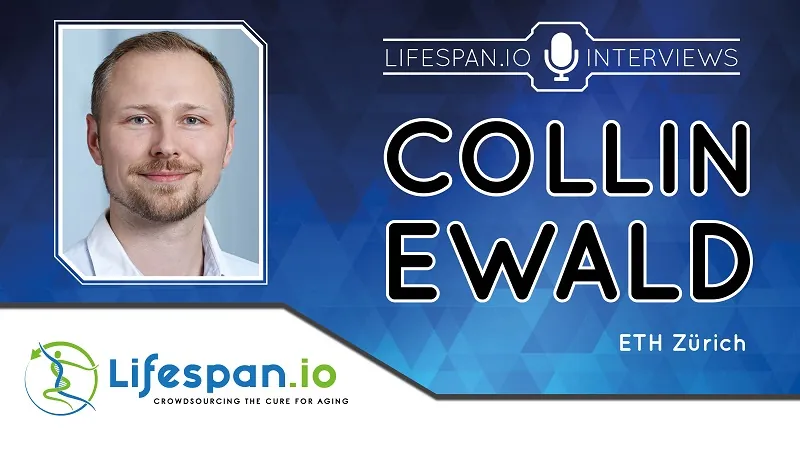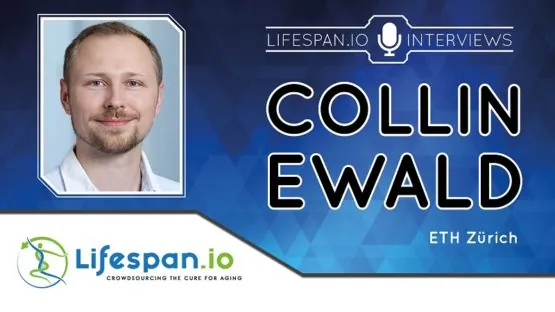Dr. Collin Ewald is a molecular biologist and a professor at the Swiss Federal Institute of Technology in Zürich (ETH). At ETH, Collin leads the Laboratory of Extracellular Matrix (ECM) Regeneration. Here, his research focuses on age-related ECM remodeling and related longevity interventions. We caught up with him to discuss his lab’s development of the “youthful matreotype” and how his team has used it to screen and validate dozens of geroprotective compounds.
Thank you for joining us, Collin. What is the ECM, and what is the matrisome?
ECM is an abbreviation for extracellular matrix. It’s a dynamic mixture of proteins, sugars, and other biomolecules that are secreted by cells into their surrounding space. At the simplest level, it determines how cells are held together and enable intercellular communication. The matrisome is the 1000+ genes encoding ECM and ECM-associated proteins. These are proteins that either form, associate with, or remodel ECM. This would include things such as collagen, TGF-β, and matrix metalloproteinases.
What is a “youthful matreotype”, and what motivated your lab to establish it?
We coined the term ‘matreotype’ to describe the acute state of ECM composition associated with or causing a given physical condition or phenotype. We thought that a youthful matreotype might predict drugs that promote healthy aging.
How did you figure out what gene expression looks like in the youthful matreotype?
We defined the youthful matreotype by using data from the Genotype-Tissue Expression (GTEx) project, which is an NIH database that helps us understand how inherited changes in genes lead to disease.
We first stratified patterns of gene expression according to the human lifespan. We defined the youthful matreotype as the ECM gene expression signature of younger human ages and cross-referenced this young matreotype expression with the CMap expression signatures of about 1300 drugs to identify longevity-promoting compounds.
For our readers who may not have heard of CMap, what is it?
CMap was created by the Broad Institute of MIT and Harvard. It’s a digital catalog of gene and protein expression patterns in human cells that have been gathered from studies of different diseases, drugs, environmental toxins, and other phenomena, including aging. Each signature is defined by a specific set of genes and proteins. The genes and proteins in each signature have complex interrelationships with each other. This database makes it possible to scan for unrecognized connections between things such as drugs, diseases, and changes in ECM related to aging.
What did CMap reveal?
We found 167 compounds that regulate most matrisome genes. When we looked at the 12 most up- and 12 most down-regulated expression profiles, we noticed 10 that were linked to either longevity or impairment of age-related pathologies. Out of 47 longevity compounds assessed in the CMap, 41 really changed matrisome gene expression. After further curation, we homed in on 20 additional compounds reported to increase longevity.
So, from a total of 67 reported lifespan-increasing drugs, 19 had minor effects on overall matrisome gene expression, whereas 26 compounds increased and 22 decreased matrisome gene expression. This suggested that many compounds implicated in healthy aging show enriched matrisomal gene expression.
Having established a youthful matreotype with a goal of identifying potential longevity drugs, what were the next steps?
More database mining. The first thing we did was search two databases: DrugAge and Geroprotectors. We looked for compounds associated with ECM and lifespan increases of 5% or more. Then, we surveyed PubMed abstracts for the compounds we identified and ECM-related terms. We chose 16 out of 567 compounds that appear to both slow aging and affect matrisomal gene expression. The next challenge after that was to determine whether treatment with these compounds would change matrisome expression.
How did you go about testing the compounds you identified as most promising?
We tested the predicted compounds on the model organism C. elegans. To do this type of study, a major challenge is that ordinarily, you can not know if the optimal dose is used until the organism has died and the study has ended. To work around this, we developed a screening test that measured collagen synthesis. Like humans, collagen synthesis declines with age in C. elegans.
In fact, we discovered that many, possibly all, longevity interventions prolong the expression of collagen genes in C. elegans. The lengthened expression of key collagen genes is required and sufficient for longevity. We reasoned that prolonged collagen expression, measured at the level of transcription (sending out instructions from DNA) would be a good surrogate marker for predicting longevity.
How did you tell if collagen synthesis was changing in response to treatment with prospective geroprotective compounds?
We attached a reporter gene called Green Fluorescent Protein (GFP) to a specific collagen promoter in C.elegans. Once the collagen is expressed, at the same time, GFP is expressed, and the worms appear fluorescent under a microscope. The intensity of GFP fluorescence can be precisely measured to quantify the effectiveness of a given intervention. In this way, we were able to determine which compounds offered the greatest potential longevity benefit and what dosage was necessary to achieve it.
What were some of the compounds you validated?
There were quite a few. Phenformin (an analog of metformin) and metformin: this was consistent with a study that showed metformin slows extracellular matrix decline. This indicates an unexplored aspect of metformin’s mechanism of action. This prompted us to focus more attention on drugs that enhance collagen homeostasis.
This made us look at the retinoic acid receptor agonist tretinoin. We tested tretinoin and found that when administered at the proper level, it increased C.elegans lifespan significantly. Our ability to find the optimal dosage enabled us to discover tretinoin’s potential as a longevity drug where other studies were not able to because they did not have a means of effectively optimizing the dosage.
We also looked at a number of compounds that could change ECM composition that were not in the CMap database. We looked at glucosamine, chondroitin sulfate, and hyaluronic acid. We found that those three compounds also increased collagen expression during aging.
Overall, we established an in-silico approach using matreotype signatures from humans to identify compounds and established a wet-lab validation system using C. elegans collagen homeostasis to demonstrate the longevity effects of these compounds.
In 2011 and 2013, two studies involving resveratrol were released. Both studies showed no longevity benefit in normal mice at 300ppm or 1200ppm, but how do we know if the mice were given an optimal dosage of resveratrol?
That’s a great question; I think more research is needed there. Hopefully, either our group or any other research group finds the answer to this, which would have huge implications, especially for personalized medicine.
Literature
[1] R. A. Miller et al., “Rapamycin, But Not Resveratrol or Simvastatin, Extends Life Span of Genetically Heterogeneous Mice,” Journals Gerontol. Ser. A, vol. 66A, no. 2, pp. 191–201, Feb. 2011
[2] R. Strong et al., “Evaluation of resveratrol, green tea extract, curcumin, oxaloacetic acid, and medium-chain triglyceride oil on life span of genetically heterogeneous mice,” J. Gerontol. A. Biol. Sci. Med. Sci., vol. 68, no. 1, pp. 6–16, Jan. 2013
[3] C. Statzer et al., “Youthful and age-related matreotypes predict drugs promoting longevity,” Aging Cell, vol. 20, no. 9, pp. 1–14, 2021
[4] C. Y. Ewald, “Drug Screening Implicates Chondroitin Sulfate as a Potential Longevity Pill ,” Frontiers in Aging , vol. 2. 2021



